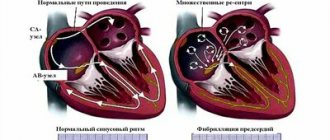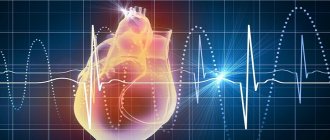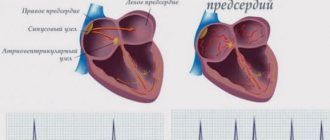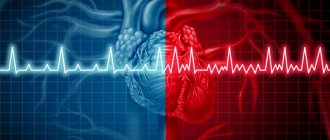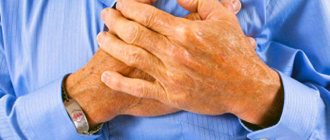IN SHORT SUMMARY : Watch your salt intake and don't be afraid to eat frozen foods.
Atrial fibrillation or atrial fibrillation is a heart rhythm disorder with frequent and chaotic excitation and contraction of the atria. The heart rate can reach 350-600 beats per minute, with the norm being 60-90 beats. With prolonged manifestation of atrial fibrillation (more than 2 days), the risk of blood clots and stroke increases.
Risk factors for such as age and genetics cannot be influenced. However, you can reduce its symptoms and the risk of cardiovascular diseases by changing your lifestyle, in particular, by reviewing your diet .
What diet to follow for atrial fibrillation?
There is no specially designed diet for patients with atrial fibrillation, but doctors suggest following the DASH diet , which is recommended for the prevention of heart disease and reducing the risk of heart attacks and strokes.
The heart-healthy DASH (Dietary Approaches to Stop Hypertension) diet consists of fruits, vegetables, whole grains, fish and poultry, and low-fat dairy products.
Examples of DASH diet menus: here and here.
A study published in Medicine in 2021 found that strict adherence to the DASH diet was associated with a reduced risk of stroke . And this is good news, since the relationship between atrial fibrillation and stroke has been established .
Fully or partially limited products
- Drinks containing caffeine (coffee, tea, tonics, energy drinks) all increase your heart rate.
- Highly extractive broths, fatty meats, lard, cooking fats, full-fat dairy products, mayonnaise, margarine, offal, sausages, smoked meats, any canned food.
- Fried foods.
- Puff pastry products, cakes, semolina, cream pies, confectionery, jam, ice cream.
- Alcohol, since drinking it provokes attacks of arrhythmia .
Table of prohibited products
| Proteins, g | Fats, g | Carbohydrates, g | Calories, kcal | |
Vegetables and greens | ||||
| radish | 1,2 | 0,1 | 3,4 | 19 |
| white radish | 1,4 | 0,0 | 4,1 | 21 |
| red radish | 1,2 | 0,1 | 3,4 | 20 |
| black radish | 1,9 | 0,2 | 6,7 | 35 |
| spinach | 2,9 | 0,3 | 2,0 | 22 |
| sorrel | 1,5 | 0,3 | 2,9 | 19 |
Berries | ||||
| grape | 0,6 | 0,2 | 16,8 | 65 |
Mushrooms | ||||
| mushrooms | 3,5 | 2,0 | 2,5 | 30 |
Cereals and porridges | ||||
| semolina | 10,3 | 1,0 | 73,3 | 328 |
| rice | 6,7 | 0,7 | 78,9 | 344 |
Flour and pasta | ||||
| pasta | 10,4 | 1,1 | 69,7 | 337 |
Confectionery | ||||
| jam | 0,3 | 0,2 | 63,0 | 263 |
| jam | 0,3 | 0,1 | 56,0 | 238 |
| candies | 4,3 | 19,8 | 67,5 | 453 |
| pastry cream | 0,2 | 26,0 | 16,5 | 300 |
| cookie | 7,5 | 11,8 | 74,9 | 417 |
Ice cream | ||||
| ice cream | 3,7 | 6,9 | 22,1 | 189 |
Cakes | ||||
| cake | 4,4 | 23,4 | 45,2 | 407 |
Chocolate | ||||
| chocolate | 5,4 | 35,3 | 56,5 | 544 |
Raw materials and seasonings | ||||
| mustard | 5,7 | 6,4 | 22,0 | 162 |
| mayonnaise | 2,4 | 67,0 | 3,9 | 627 |
Dairy | ||||
| milk 3.6% | 2,8 | 3,6 | 4,7 | 62 |
| milk 4.5% | 3,1 | 4,5 | 4,7 | 72 |
| cream | 2,8 | 20,0 | 3,7 | 205 |
| sour cream 25% (classic) | 2,6 | 25,0 | 2,5 | 248 |
Cheeses and cottage cheese | ||||
| cheese | 24,1 | 29,5 | 0,3 | 363 |
| cottage cheese 11% | 16,0 | 11,0 | 1,0 | 170 |
| cottage cheese 18% (fat) | 14,0 | 18,0 | 2,8 | 232 |
Meat products | ||||
| pork | 16,0 | 21,6 | 0,0 | 259 |
| pork liver | 18,8 | 3,6 | 0,0 | 108 |
| pork kidneys | 13,0 | 3,1 | 0,0 | 80 |
| pork fat | 1,4 | 92,8 | 0,0 | 841 |
| salo | 2,4 | 89,0 | 0,0 | 797 |
| beef liver | 17,4 | 3,1 | 0,0 | 98 |
| beef kidneys | 12,5 | 1,8 | 0,0 | 66 |
| beef brains | 9,5 | 9,5 | 0,0 | 124 |
Sausages | ||||
| smoked sausage | 16,2 | 44,6 | 0,0 | 466 |
| smoked sausage | 9,9 | 63,2 | 0,3 | 608 |
| sausages | 10,1 | 31,6 | 1,9 | 332 |
| sausages | 12,3 | 25,3 | 0,0 | 277 |
Bird | ||||
| smoked chicken | 27,5 | 8,2 | 0,0 | 184 |
| duck | 16,5 | 61,2 | 0,0 | 346 |
| smoked duck | 19,0 | 28,4 | 0,0 | 337 |
| goose | 16,1 | 33,3 | 0,0 | 364 |
Fish and seafood | ||||
| smoked fish | 26,8 | 9,9 | 0,0 | 196 |
| salted fish | 19,2 | 2,0 | 0,0 | 190 |
| Red caviar | 32,0 | 15,0 | 0,0 | 263 |
| black caviar | 28,0 | 9,7 | 0,0 | 203 |
| canned fish | 17,5 | 2,0 | 0,0 | 88 |
| cod (liver in oil) | 4,2 | 65,7 | 1,2 | 613 |
Oils and fats | ||||
| animal fat | 0,0 | 99,7 | 0,0 | 897 |
| cooking fat | 0,0 | 99,7 | 0,0 | 897 |
Non-alcoholic drinks | ||||
| instant coffee dry | 15,0 | 3,5 | 0,0 | 94 |
| black tea | 20,0 | 5,1 | 6,9 | 152 |
| * data is per 100 g of product | ||||
What's not allowed?
Caffeine . Caffeine is contraindicated for most patients with atrial fibrillation. It speeds up your heart rate and may worsen symptoms. If you can't give up coffee and tea, there's good news: a 2021 study that examined the relationship between arrhythmia and caffeine found that it's safe to consume up to 300 mg of the substance per day. However, it is best to discuss this issue with your doctor.
Salt . It is very important to limit it, since salt abuse can lead to increased blood pressure, which, in turn, increases the risk of atrial fibrillation. The foods most of us are accustomed to contain too much salt. Avoiding processed foods and processed foods and replacing salt with seasonings is a smart nutrition strategy for everyone, especially those with heart disease.
What foods should you avoid? An infographic from the American Heart Association will tell you.
Proper eating
Before the names of the most heart-healthy foods, the rules of eating should be mentioned. They must be adhered to constantly, as this will help maintain or maintain health at the proper level.
- You need to eat about 3-4 times a day.
- You should sit down to eat only when you have an appetite.
- Eating should take place in a calm state. It is unacceptable to eat when you are in a bad mood or excited.
- Food should be at a comfortable temperature. You cannot eat supercooled or hot food “on the run.”
- While eating, you should not read, watch TV, use gadgets or talk loudly. The best digestibility of food occurs with concentrated consumption against the backdrop of positive thinking.
- Food must be chewed thoroughly.
- Finishing your meal on time means leaving the table a little hungry.
The diet must be built taking into account the ratio of food varieties. The largest share of food comes from plant origin - up to 60%, carbohydrate products are consumed no more than 25%, and protein products - no more than 30%. In addition, it is important not to overdo it with fluid intake, the volume of which should be reduced by half.
What is possible?
Frozen fruits and vegetables . They are even preferable to fresh ones, although it was previously believed that some nutrients and vitamins were lost when frozen. This is wrong. Fruits and vegetables that are frozen are harvested when fully ripe and using the most modern methods (for example, blast freezing), trying to preserve their nutritional value as much as possible. But during transportation to stores, which can take from several days to weeks, fresh vegetables and fruits lose their beneficial properties. In addition, they are harvested before they are fully ripe, which means they inherently contain fewer nutrients and vitamins.
Liquid . It is important for patients with atrial fibrillation to know that dehydration worsens symptoms. It is necessary to drink enough water and other liquids throughout the day, include foods containing potassium and magnesium - fruits, vegetables, fish, whole grains, beans, nuts, green leafy vegetables (but not dietary supplements).
Authorized Products
Diet for cardiac arrhythmia includes:
- Vegetables that occupy the main place in the diet. You need to eat 350-400 g of vegetables per day. Use different vegetable salads as a side dish for meat and fish. Prepare a stewed vegetable stew, including cabbage, beets, zucchini, pumpkin, and eggplant. Among vegetables, all types of cabbage are useful as a low-calorie potassium-containing product. Limit your potato intake, especially when it comes to weight loss. All red-purple vegetables contain polyphenols that stimulate HDL production. Eggplants, beets, and red cabbage are good for high cholesterol .
- Beans and soy products can replace meat due to their high protein content. If they are well tolerated, you should include them in your diet more often.
- Healthy fruits: pomegranate, viburnum, dogwood, blueberries, bananas, raspberries, strawberries, blackberries, chokeberries, lingonberries, cherries, currants, apples, apricots, red grapes, cranberries, since many of them help reduce cholesterol levels in the blood and improve rheological blood properties (thin the blood). Fruits and berries can be used during snacks and preferably raw. If we talk about the content of pectins (they remove cholesterol from the body), then the largest amount is in apples, viburnum, citrus fruits, cranberries, dried dogwood berries, and grapes.
- Fish and seafood dishes should prevail in the diet over meat dishes. Give preference to low-fat fish and occasionally allow yourself fatty fish. The benefits of seaweed are great, which can be added in dried form to all dishes.
- Dietary lean meat and poultry - you can eat them once a week, cook them boiled or baked. If you want baked meat or poultry, you should first boil them and then bake them. This technique reduces the cholesterol and fat content in the product.
- First courses cooked in water. Prefer vegetable soups to cereal soups due to their low calorie content.
- Various cereals in the form of porridges and casseroles. Considering their composition, it is better to prefer buckwheat and oatmeal. If you need to lose weight, reduce the quantity and frequency of porridge consumption.
- Black or bran bread, rich in magnesium and fiber. For dessert, choose savory cookies or savory grain breads.
- Unrefined vegetable oils should make up the majority of the fat. Use oils in their natural form, and alternating them will diversify your diet. Olive oil is rich in oleic fatty acid (MUFA representative). Corn, sunflower and cottonseed oil are sources of omega-6 , and flaxseed, soybean, rapeseed, sesame, and mustard oils contain omega-3 fatty acids.
- Eating a handful of any nuts or seeds daily will enrich your diet with potassium, magnesium and monounsaturated fats. Be aware that these foods are high in calories, so eat them in moderation. Sunflower and pumpkin seeds, pistachios, almonds, pine nuts also contain phytosterols and phytostanols , which are useful in reducing cholesterol levels.
- Milk, cottage cheese, cheeses, and fermented milk drinks should be chosen with low fat content. Avoid heavy cream and sour cream.
- Weak green tea with lemon, you can add chamomile, oregano, thyme, rosehip infusion, juices, mineral water. With heart failure and the appearance of edema , the amount of fluid you drink is limited.
Table of permitted products
| Proteins, g | Fats, g | Carbohydrates, g | Calories, kcal | |
Vegetables and greens | ||||
| greenery | 2,6 | 0,4 | 5,2 | 36 |
| eggplant | 1,2 | 0,1 | 4,5 | 24 |
| beans | 6,0 | 0,1 | 8,5 | 57 |
| zucchini | 0,6 | 0,3 | 4,6 | 24 |
| cabbage | 1,8 | 0,1 | 4,7 | 27 |
| broccoli | 3,0 | 0,4 | 5,2 | 28 |
| boiled cauliflower | 1,8 | 0,3 | 4,0 | 29 |
| bulb onions | 1,4 | 0,0 | 10,4 | 41 |
| carrot | 1,3 | 0,1 | 6,9 | 32 |
| cucumbers | 0,8 | 0,1 | 2,8 | 15 |
| salad pepper | 1,3 | 0,0 | 5,3 | 27 |
| salad | 1,2 | 0,3 | 1,3 | 12 |
| beet | 1,5 | 0,1 | 8,8 | 40 |
| celery | 0,9 | 0,1 | 2,1 | 12 |
| soybeans | 34,9 | 17,3 | 17,3 | 381 |
| asparagus | 1,9 | 0,1 | 3,1 | 20 |
| tomatoes | 0,6 | 0,2 | 4,2 | 20 |
| Jerusalem artichoke | 2,1 | 0,1 | 12,8 | 61 |
| pumpkin | 1,3 | 0,3 | 7,7 | 28 |
| beans | 7,8 | 0,5 | 21,5 | 123 |
| garlic | 6,5 | 0,5 | 29,9 | 143 |
| lentils | 24,0 | 1,5 | 42,7 | 284 |
Fruits | ||||
| avocado | 2,0 | 20,0 | 7,4 | 208 |
| oranges | 0,9 | 0,2 | 8,1 | 36 |
| pomegranate | 0,9 | 0,0 | 13,9 | 52 |
| grapefruit | 0,7 | 0,2 | 6,5 | 29 |
| pears | 0,4 | 0,3 | 10,9 | 42 |
| kiwi | 1,0 | 0,6 | 10,3 | 48 |
| lemons | 0,9 | 0,1 | 3,0 | 16 |
| mango | 0,5 | 0,3 | 11,5 | 67 |
| tangerines | 0,8 | 0,2 | 7,5 | 33 |
| nectarine | 0,9 | 0,2 | 11,8 | 48 |
| peaches | 0,9 | 0,1 | 11,3 | 46 |
| apples | 0,4 | 0,4 | 9,8 | 47 |
Berries | ||||
| gooseberry | 0,7 | 0,2 | 12,0 | 43 |
| Red currants | 0,6 | 0,2 | 7,7 | 43 |
| black currant | 1,0 | 0,4 | 7,3 | 44 |
Nuts and dried fruits | ||||
| nuts | 15,0 | 40,0 | 20,0 | 500 |
| cashew | 25,7 | 54,1 | 13,2 | 643 |
| sesame | 19,4 | 48,7 | 12,2 | 565 |
| flax seeds | 18,3 | 42,2 | 28,9 | 534 |
| fenugreek seeds | 23,0 | 6,4 | 58,3 | 323 |
| sunflower seeds | 20,7 | 52,9 | 3,4 | 578 |
Cereals and porridges | ||||
| buckwheat (kernel) | 12,6 | 3,3 | 62,1 | 313 |
| oat groats | 12,3 | 6,1 | 59,5 | 342 |
| cereals | 11,9 | 7,2 | 69,3 | 366 |
| millet cereal | 11,5 | 3,3 | 69,3 | 348 |
| barley grits | 10,4 | 1,3 | 66,3 | 324 |
Raw materials and seasonings | ||||
| honey | 0,8 | 0,0 | 81,5 | 329 |
Dairy | ||||
| skim milk | 2,0 | 0,1 | 4,8 | 31 |
| natural yogurt 2% | 4,3 | 2,0 | 6,2 | 60 |
Cheeses and cottage cheese | ||||
| cottage cheese 0.6% (low fat) | 18,0 | 0,6 | 1,8 | 88 |
| curd tofu | 8,1 | 4,2 | 0,6 | 73 |
Meat products | ||||
| beef | 18,9 | 19,4 | 0,0 | 187 |
| rabbit | 21,0 | 8,0 | 0,0 | 156 |
Sausages | ||||
| boiled diet sausage | 12,1 | 13,5 | 0,0 | 170 |
Bird | ||||
| chicken fillet | 23,1 | 1,2 | 0,0 | 110 |
| turkey | 19,2 | 0,7 | 0,0 | 84 |
Fish and seafood | ||||
| fish | 18,5 | 4,9 | 0,0 | 136 |
| squid | 21,2 | 2,8 | 2,0 | 122 |
| mussels | 9,1 | 1,5 | 0,0 | 50 |
| seaweed | 0,8 | 5,1 | 0,0 | 49 |
Oils and fats | ||||
| butter | 0,5 | 82,5 | 0,8 | 748 |
| linseed oil | 0,0 | 99,8 | 0,0 | 898 |
| olive oil | 0,0 | 99,8 | 0,0 | 898 |
| sunflower oil | 0,0 | 99,9 | 0,0 | 899 |
Non-alcoholic drinks | ||||
| mineral water | 0,0 | 0,0 | 0,0 | — |
| green tea | 0,0 | 0,0 | 0,0 | — |
| * data is per 100 g of product | ||||
Watch your calories
Maintaining a healthy weight is important to reduce symptoms of atrial fibrillation. Move more, count calories, eliminate sweets, baked goods, fatty and processed foods from your diet. Discuss your meal plan with a nutritionist, and use smartphone apps that help you count calories and determine the amount of calories and nutrients in foods (Lose It!, Fooducate, MyFitnessPal). They can be downloaded from the App Store and Google Play.
Join us on social networks!
Subscribe to Telegram!
Menu for the week
On the first day of the week, you should start the day with porridge made from oatmeal or buckwheat flakes. The main meal may include vegetable soup, and dinner may include vegetables and some poultry.
You can also start the second day with porridge, for example, semolina. For lunch you should eat fish soup, and for dinner - some veal with salad.
It’s better to start the third day with a casserole. For lunch - borscht with lean meat, and for dinner choose durum wheat pasta.
The fourth day also begins with porridge; for lunch you can eat fish with vegetable salad. For dinner you can eat stewed cabbage with rabbit meat.
The fifth day can begin with semolina porridge with milk. During your main meal, you should eat a steamed cutlet, perhaps with baked potatoes or fish soup. For dinner, a vegetable casserole is best, or maybe with chicken.
On the sixth day, a casserole or buckwheat porridge is suitable for breakfast. For the main meal, you can choose soup, especially one containing cauliflower, with lean meat or cutlet.
On the seventh day, you can prepare a steamed omelet for breakfast. For lunch, vegetable soup with chicken is suitable, and for dinner - fish cutlets with buckwheat or pearl barley porridge.
The above menu is suitable for patients suffering from various types of heart diseases.
Drinking regime
People who have heart disease usually suffer from swelling. But this doesn't mean you need to stop drinking. On the contrary, frequent consumption of water helps relieve the kidneys. Those suffering from heart disease are recommended to drink about one and a half liters of water per day. This can be either ordinary water or mineral water (preferably without gas).
Herbal teas and herbal mixtures are very useful. For example, tea made from berries or flowers of rose hips and hawthorn. Medicinal herbs have a good effect: mint, thyme, lemon balm, calendula. They have the ability to relieve nervous tension, improving heart rate. You can also drink green tea (it is better to add honey instead of sugar), it contains useful antioxidants.
Coffee fans are better off switching to coffee substitutes, such as chicory, which tastes like coffee but is much healthier for the cardiovascular system.
The consumption of vegetable and fruit juices is allowed, preferably freshly squeezed. In this case, all drinks should be at room temperature; tea can be drunk hot, but not scalding.
